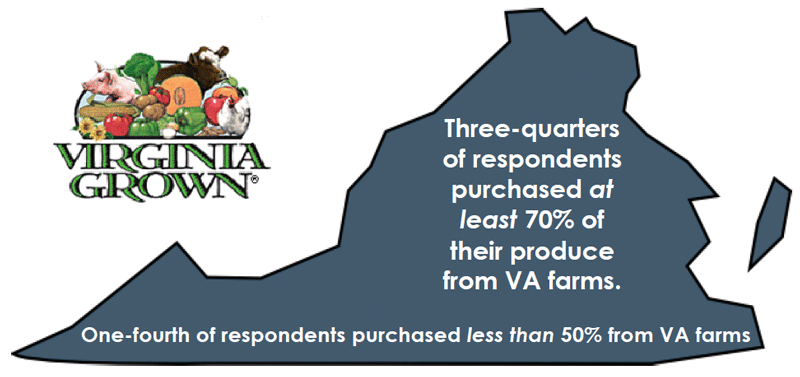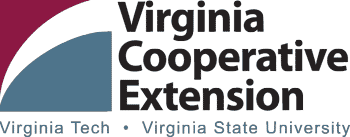Market Cross-Sector Comparison
To learn more about the specific different markets surveyed and overall trends seen across all market sectors, click on the tabs below.
Markets Surveyed in our Assessment
- Colleges & Universities
- Direct-to-Consumer Outlets
- Hospitals
- Public Schools (K-12)
- Restaurants
- Retailers
- Regional Wholesalers
While the overall response rate for our market assessment was not as large as expected, the data does provide valuable insights. The fact that public information regarding procurement policies for certain sectors was difficult to obtain indicates that buyers need to be more transparent and better communicate their food safety requirements to producers. Further, a lack of available information may also indicate that there are certain markets that are challenging for Virginia producers to tap into, assuming these markets may instead be sourcing produce through larger suppliers and broad-line distributors.
Of the 46 survey respondents, 72% view buying local produce as important, with quality, availability, and price identified as the top three purchasing priorities. Although the survey was specifically targeted at food safety perceptions and expectations, other constraints (e.g. logistics, variety, price, volume, seasonality) related to purchasing from local farms featured more prominently. Given that most respondents communicate their standards to suppliers verbally, there is likely little consistency across sectors on the message growers are receiving related to quality assurance. Consistent themes across sectors demonstrated the importance of relationship building and communication between producers and buyers. Given the complexities inherent in fresh produce supply chains, these factors were emphasized repeatedly.

Purchasing Priorities (Ranked most to least important)
- Quality- Features and desirable product characteristics in terms of handling and customer expectations. This includes consistent size, shape, color, level of ripeness, freshness, taste, nutrition, etc..
- Availability- Denotes the timing or seasonality of when a given amount of a product will be available. This priority is especially important so buyers can plan and determine reliability of given products for their particular market. Additionally, seasonal availability can have a large influence on product prices obtained.
- Price- The quantity of payment or compensation given by one party to another in order to acquire a given quantity of goods or services. Many factors can influence the prices obtained by the producer.
- Deliverability- Buyers of your products have formed a relationship with you and expect you to be reliable in terms of your business operations and services. In terms of delivery, this means providing the type and amount of product as agreed upon at the time business transactions were made. When applicable it also means dependability in transporting and transferring your product to the buyer.
- Product Variety- The ability to provide various types of produce for purchase. While this can mean a diverse array of different types of vegetables or fruits, it could also mean several types of something within the same category, i.e. cherry, grape, plum, slicing, and heirloom tomatoes.
- Quantity- The deliverable volume or amount of actual produce transferred from producer to buyer. This can either refer to a specified unit or by set weight of product.
- Food Safety Certification- This refers to the food safety certifications obtained by the producer to demonstrate their knowledge and implementation of sound on-farm food safety principles, as well as post-harvest handling practices. In some cases this may mean Good Agricultural Practices (GAP) or Global Food Safety Initiative (GFSI) audits, whereas in others it might pertain to a Hazard Analysis and Critical Control Points (HACCP) plan or ServSafe certification.
- Grower Proximity to Buyer- Refers to the physical distance between the producer and the buyer. This factor can have a large bearing on operational costs and feasibility for accessing a particular market.
- Product Liability Insurance- Liability coverage provides payments to an injured party, and to defend a producer against lawsuits. It can provide protection in the event a consumer becomes ill from eating or using your product. This can also refer to the coverage of the product if there were to be any damage or circumstantial matter that caused the agreed upon volume or quality of product to not be delivered to the buyer.
Requirements for food safety certification was represented in the wholesale, institutional, and K-12 market sectors. In other sectors there was an indication that distributors are relied upon to verify supplier adherence to food safety practices and overcome logistical challenges, while some rely solely on verbal assurances and established relationships to address food safety and quality assurances. The complexity of supply chains was evident, given the varied and inconsistent procurement strategies in place. Across all market sectors, purchasing direct from the grower was prioritized, presumably linked to the value of relationships and support of local food systems. However, the logistical hurdles faced were also substantial, with a perceived need for more intermediaries like food hubs to streamline access to local foods.
- For those buyers requiring a food safety audit, 41% accept USDA GAP and HGAP audits; 15% accept Global Food Safety Initiative (GFSI) audits; 7% require other inspections (health department sanitation or food service company quality inspections).
- While 30% of these buyers allow a graduated process for “on-boarding” new growers/vendors in terms of food safety practices and certifications—i.e. obtaining a USDA Good Agricultural Practices (GAP) audit prior to a Harmonized GAP audit—65% did not know whether their organizations permitted this option.
- Key on-farm food safety practices buyers would like to see are water testing, safe manure/compost use, animal exclusion, and water treatment (when needed), along with refrigeration and storage of product.
- In developing buyer standards or requirements, 39% to 56% of the respondents have relied on federal and state agencies for support, such as USDA, FDA, Virginia Department of Health (VDH), and Virginia Department of Agriculture and Consumer Services (VDACS). 17-20% have relied on Virginia Cooperative Extension (VCE), produce industry associations, suppliers, and other industry food safety organizations.
- When buyers were asked about familiarity with the Food Safety Modernization Act (FSMA), 34% (14/41) of respondents were not familiar (had not heard of it); 51% (21/41) of respondents were somewhat familiar (knew about it but did not know details); and 15% (6/41) were fairly familiar (knew about how it would affect their organization).
- 65% (11/17) of respondents anticipate their food safety requirements changing due to the FSMA.
- Over 35% of the buyers said they would be willing to provide their time by serving in a fresh produce food safety working group and/or hosting/presenting at a grower workshop.
While the data indicates that certain market sectors do not have defined food safety requirements and base procurement decisions largely on relationships and verbal agreements, it would be ill-advised for growers to not prioritize food safety plans and verification given the lack of general knowledge and consistency in the marketplace. There appears to be an area of opportunity to address food safety, along with logistical challenges that buyers face, building these values and strategies into a local brand development. In addition, market sectors would benefit from increased access to education related to on-farm food safety practices, and procurement policies, especially given the growth in supply of locally grown produce.
Helpful Resources
Accessing Virginia’s Market Sectors: Fresh Produce Purchasing Considerations FactsheetFood Safety Webinar (Part 1)
This CFN food systems webinar was Part 1 of a two-part webinar series exploring the basics of food safety laws impacting fruit and vegetable farmers, food hubs, and distributors. Resources for producers in the Mid-Atlantic region were highlighted. Includes a 15 minute overview of the project (09.00-23.00).
Managing Legal Liability Series
These factsheets can help you learn more about important farm liability issues; however, as with any legal matters, please consult with your insurance agent or attorney for guidance and most up-to-date advice.
Managing Liability
A nice booklet covering basic liability principles for direct market and agritourism operations.
